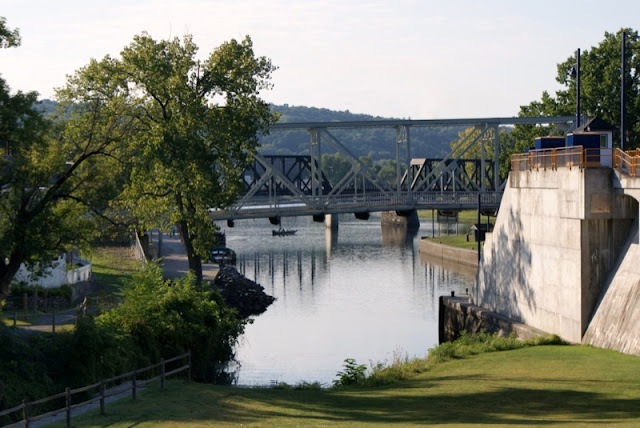Waterford Canal Welcome Center
We have a slip rented in Ithaca, NY on Cayuga Lake for the summer. The map above show the Erie Canal, the Finger Lakes and Ithaca. The only way to get to Ithaca is through the Erie Canal. While we wait for the season opening of the canal we'll enjoy Waterford. Here's a little history of the Erie Canal. Construction of the Erie Canal began on July 4, 1817, in Rome, New York and was completed on October 25, 1825. This year begins the bicentennial celebration that will last eight years. The original Canal was four feet deep and 40 feet wide, it cut through fields, forests, rocky cliffs, and swamps; crossed rivers on aqueducts; and overcame hills with 83 lift locks. The project engineers and contractors had little experience building canals, so this engineering marvel served as the nation’s first practical school of civil engineering.
The entire length of the Erie Canal is 363 miles, when it opened in 1825 it served as the water gateway to the west, connecting New York City to the Great Lakes and providing a cost-efficient mode of transporting freight to western portions of the state and eventually the country. Canal packet boat passengers could now travel in relative comfort from Albany to Buffalo in five days instead of the two weeks it took in crowded stagecoaches.
The Canal opened the American interior to settlement, and brought a flow of people and new ideas to the western states. These newcomers infused the nation with different languages, customs, practices, and religions.
The U.S. Congress recognized the Erie Canal’s significance to our nation by establishing the Erie Canalway National Heritage Corridor in 2000. The Corridor stretches 524 miles across the full expanse of upstate New York, from Buffalo to Albany and north along the Champlain Canal to Whitehall. It threads 234 diverse communities connected by a waterway that changed not just the landscape of the state of New York, but also our nation and its history.
The development of the railroad in the 19th century and the automobile in the 20th century sealed the fate of the Erie Canal. Now, the canals are primarily used for pleasure boating - bike paths, trails, and recreational marinas line the canal.
In the early 1900s a larger barge canal took the place of some of the original locks of the Erie. This is the 1910 construction of Lock 2 right above where our boat is docked in Waterford.
Lock 2 in 1911
This picture of Lock 2 was taken in 2012 when we made our first trip through the Erie Canal.
Looking down from Lock 2 towards the wall in Waterford
Lock 3 above Waterford in 1911
Lock 3 above Waterford in 1920
Looking towards Lock 2 from Lock 3 above Waterford
The old towpaths are now used as cycling and walking trails











No comments:
Post a Comment